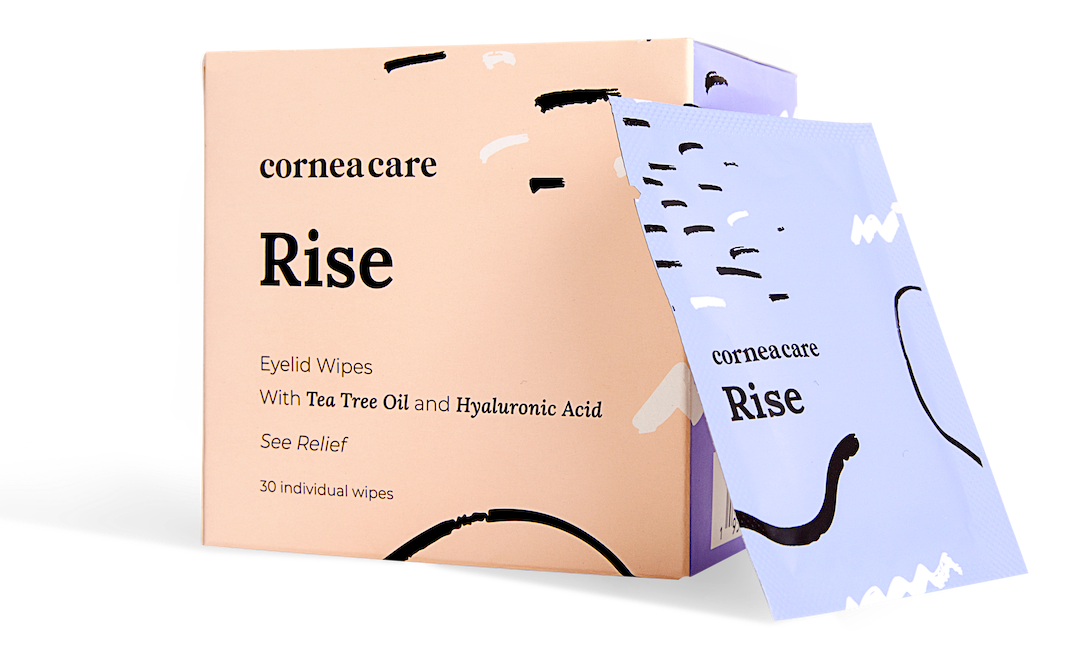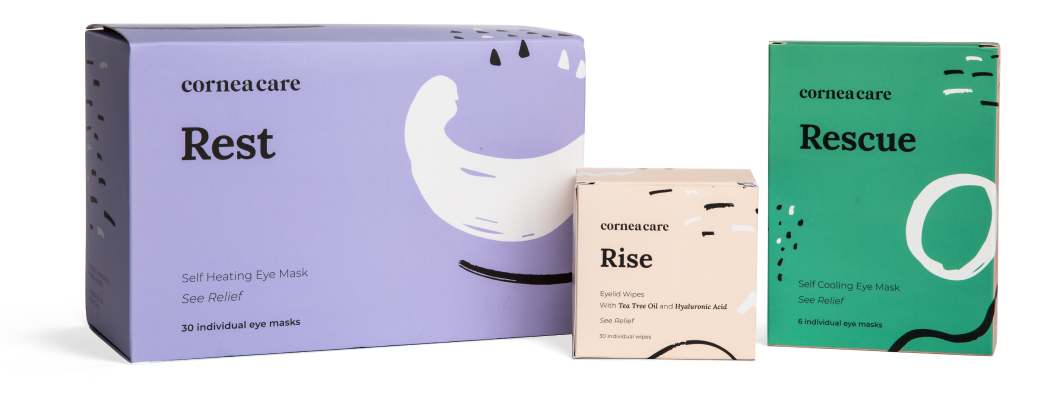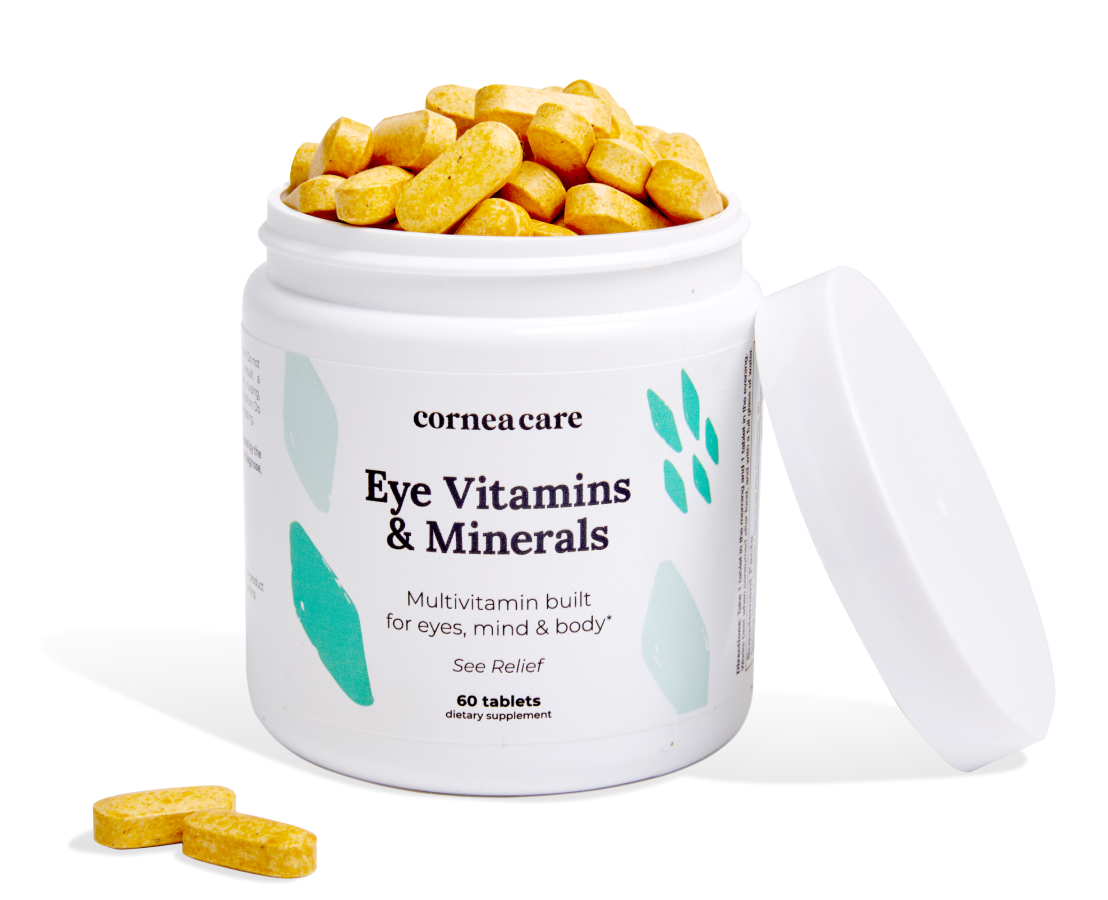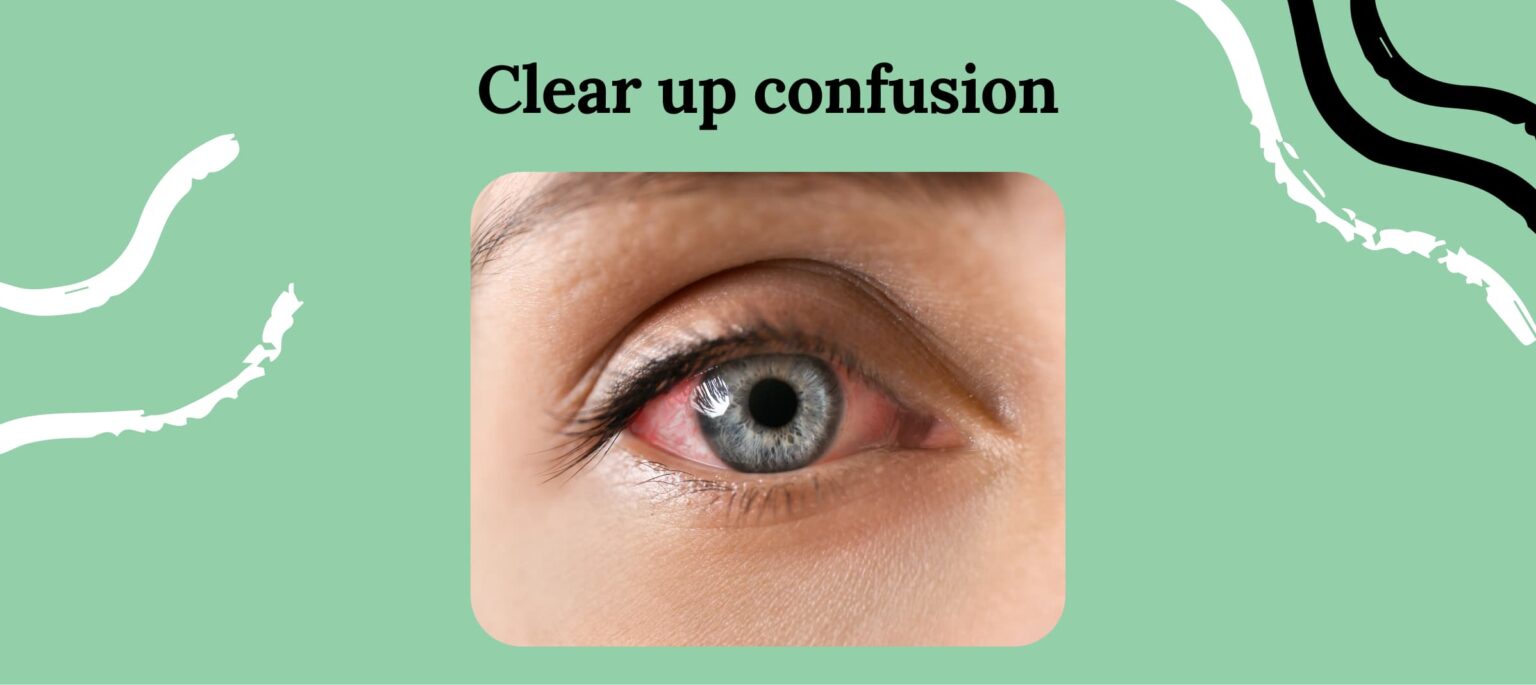Is it Pink Eye or Allergy Eyes?
The symptoms of pink eye and the symptoms of allergy eyes can be very similar. With either, you usually experience redness and watery eyes. These similarities make it confusing to figure out which one you have! However, these eye conditions have very different causes. So how can you tell the difference between allergy eyes vs pink eye?
Allergy eyes and pink eye are both a type of conjunctivitis. Conjunctivitis means inflammation, or swelling, of the conjunctiva. The conjunctiva is the membrane that covers your eyeball and the inside of your eyelids.
This post will help you better understand the types of conjunctivitis, the causes and treatments, and how to identify allergy eyes vs pink eye. If your symptoms are severe and interfere with your daily life, call your eye doctor (optometrist or ophthalmologist).
Key Points
- Allergy eyes and pink eye are types of conjunctivitis (inflammation of the membranes covering the white of the eye and inside of the eyelids).2
- Bacterial and viral forms of pink eye are highly contagious and hand washing can help prevent its spread.2
- The best way to prevent allergy eyes is to avoid the allergens that trigger a reaction in you.
Allergy Eyes vs Pink Eye
When you hear the term “pink eye” you probably think of the contagious eye infection often associated with children. The term can describe the appearance of eyes that look reddish or pink due to contagious bacterial infection or viral infection, or other non-contagious causes such as an allergic reaction or a reaction to environmental irritants.1
Pink eye and allergy eyes are types of conjunctivitis, which means inflammation of the conjunctiva. The conjunctiva is the outer membrane that covers the white of the eye and the inside of the eyelids.2
Types of Conjunctivitis
The symptoms of pink eye are similar across most types of conjunctivitis, though the causes are varied. Thus, the main factor when considering whether you have allergy eyes vs pink eye usually comes down to the cause. Different types of conjunctivitis can be caused by infection, allergens, or environmental irritants.
Viral Conjunctivitis
The most common form of pink eye, viral conjunctivitis is highly contagious and often spreads quickly among children. It’s fairly common for viral conjunctivitis to occur in people who either have a cold or recently did. Like the common cold, you can easily catch the viral form of pink eye from other people’s hands or surfaces they touched.2
With viral conjunctivitis, you or your child may have watery red eyes that heal within a week or two. However, it’s important to keep your hands clean and avoid touching the eyes.
When considering the question of allergy eyes vs pink eye, viral conjunctivitis is highly contagious and clears up on its own, unlike allergy eyes. Moreover, viral conjunctivitis will usually affect one eye and then spread to the other eye. Eye allergies typically affect both eyes at the same time.
Treatment for Viral Pink Eye
While you have to be careful not to spread viral pink eye among friends or classmates, the eye infection itself is mild. Viral pink eye usually clears up in just 7 to 14 days.1
There is no cure for viral conjunctivitis but you can ease the symptoms with cool compresses and artificial tears. Try CorneaCare’s self-cooling cold compress and preservative-free artificial tears for soothing relief. Always wash your hands first, and be careful not to touch the eye with the tip of the eye drop bottle.
In some cases, viral conjunctivitis may be caused by the herpes simplex virus or varicella-zoster virus. If your healthcare provider determines one of these viruses to be the cause, they may prescribe antiviral drugs.1
Bacterial Conjunctivitis
Pink eye caused by a bacterial infection is called bacterial conjunctivitis or bacterial pink eye and is far less common than viral pink eye. In addition to the common symptoms of pink eye, with bacterial pink eye you may have crusty or sticky yellowish discharge. This mucus discharge can cause your eyelids to stick together.2
Bacterial conjunctivitis is highly contagious. Take precautions to prevent spreading this type of pink eye by washing your hands thoroughly if you have the condition or you’re caring for a child with bacterial pink eye.2
Treatment for Bacterial Pink Eye
If your doctor determines that a bacterial infection is causing your pink eye symptoms, they may prescribe antibiotic treatment. You may get them in the form of topical ointments or antibiotic eye drops.2
While a mild case of bacterial pink eye may resolve without antibiotics in 2 to 5 days, you may be contagious longer. Antibiotic treatment for bacterial conjunctivitis can help shorten the length of infection. This can also lower the chance of spread and reduce the risk of complications.1
When you’re wondering if it’s allergy eyes vs pink eye, remember that bacterial pink eye is highly contagious, may cause sticky yellow discharge, and may require antibiotic treatment, unlike allergy eyes.

Rise
Eyelid Wipes
Perfect for eye dryness, itching, burning, and crusting/flaking of eyelashes. Free shipping 📦
Try today - $25
Allergic Conjunctivitis (Allergy Eyes)
Allergic conjunctivitis or allergy eyes can be triggered by allergens such as pollen, pet dander, smoke, or dust mites. When conjunctivitis is caused by allergies, you’ll have red eyes and tearing plus additional symptoms of eye allergies. These may include:3
- Scratchy, gritty feeling in your eye
- Intense itching of your eyes
- Swollen eyes
- Burning or sore eyes
If an allergic reaction is causing your pink eyes, you will likely have other allergy symptoms such as:4
- Sneezing or itchy, runny nose
- Congestion
- Itchiness at the roof of the mouth
- Throat irritation
- Dark circles or bags under the eyes
Though it may look similar to contagious pink eye, allergic conjunctivitis isn’t contagious.
Treatment for Allergy Eyes
Eye drops can ease itchy eyes when you suffer from eye allergies due to seasonal allergies or other irritants.
If you wear contact lenses, remove them and switch to glasses as soon as you notice irritation or redness. With the rubbing that comes with itchy, watery eyes you’re more likely to get an eye infection if you’re using contact lenses.
Allergic conjunctivitis can be treated with over-the-counter products or prescription medication. Your doctor or allergist may recommend antihistamines, either in oral form or eye drops, to block the histamine effect in the body.4
In the case of severe or chronic allergic conjunctivitis, your doctor may give steroids, allergy shots, or immunotherapy treatment.
Preventing Allergy Eyes
The most effective way to prevent an allergic reaction that causes eye allergy symptoms is to avoid the trigger when possible. Here are some tips that can help:4
- If you’re allergic to pollen, pay attention to high pollen alerts in your area. Stay indoors with your windows closed and the air conditioner on.
- Avoid animal dander if that’s your trigger by keeping pets in a separate room. Wash your hands after touching them.
- Allergy testing can help you identify foods or substances that trigger your allergy eyes. Avoid your allergens by reading food labels carefully.
- If dust mites or mold are your triggers, use a dehumidifier to reduce humidity in your home. Humid conditions can encourage the growth of these allergens.
- Quit smoking and avoid secondhand smoke that can irritate eyes and cause redness, tearing, and itchy eyes.
- Use a gentle insect repellant or wear protective clothing to avoid insect bites that may trigger an allergic reaction.
- Choose fragrance-free products and household cleaners, and avoid perfumes.
Artificial tears can help prevent eye irritation caused by allergens while also preventing dry eye symptoms. Check out Allergies and Dry Eyes: Are they Related?
In terms of the allergy eyes vs pink eye question, allergy eyes are triggered by allergens and usually occur with other allergy symptoms like sneezing. Further, allergy eyes are not contagious, unlike bacterial and viral pink eye. Lastly, viral conjunctivitis typically affects one eye and spreads to the other, while bacterial conjunctivitis only affects one eye. Allergy eyes affect both eyes at the same time.

All Rounder
Eyelid Hygiene Plan 3
Perfect for eye dryness, burning, itching, grittiness, crusting/flaking of eyelashes and inflamed/swollen eyelids. Free shipping 📦.
Try today - $60
Mechanical or Chemical Irritation Conjunctivitis
Redness and tearing caused by getting something in your eye is called mechanical irritation conjunctivitis. You might experience this type of pink eye if makeup, an eyelash, or other foreign object gets in your eye.
Chemical conjunctivitis is pink eye caused by chemical irritants used in the workplace, chlorine from swimming pools or fumes, smoke, and other air pollution.
Treatment
Treatment requires flushing the eyes with water or a saline wash.5 Like removing a contact lens stuck in your eye, flushing out a minor irritant with artificial tears can be effective.
It’s important to wash your hands before using a fingertip to gently remove the foreign object. To avoid damage to your eye, contact your healthcare provider for advice.
In the case of a severe chemical injury to the eyes, seek immediate medical attention. Your doctor may recommend topical antibiotics, topical steroids or surgery in severe cases.5
To prevent eye injuries on the job, familiarize yourself with workplace safety guidelines including wearing protective eyewear.
Inflammatory Conjunctivitis
Inflammatory eye conditions such as iritis (inflammation of the iris), blepharitis (inflammation of the eyelid), or a stye (red bump caused by clogged oil glands) can cause pink eye symptoms. Dry eye disease may also cause pink, irritated eyes.
Treatment
Inflammatory eye conditions may require prescription medication. However, CorneaCare’s self-heating warm compress can soothe the discomfort caused by a stye. Blepharitis may respond to CorneaCare’s eyelid wipes, which contain tea tree oil and hyaluronic acid.
If your symptoms are related to dry eye disease, we recommend starting a daily eyelid hygiene routine. You may also want to try preservative free artificial tears for soothing relief. Also consider adding eye vitamins and omega 3 supplements to fill any nutritional gaps in your diet.

Multivitamin
Eye Vitamins & Minerals
A single multivitamin to address the nutritional needs of your eyes, mind and body. 📦 Free shipping.
Try today - $35
When to See a Doctor
If your pink eye symptoms worsen or don’t improve after a week, or you have any of the following in addition to conjunctivitis, see a healthcare provider:1
- Eye pain
- Light sensitivity
- Headache
- Blurred vision
- Thick mucoid discharge
- Weakened immune system
Putting It All Together
Conjunctivitis is widely known as pink eye and can be caused by infection, allergies, chemical exposure, or inflammatory eye conditions. The most common symptoms of pink eye are redness and tearing.
Now that you know the different types of conjunctivitis, you may have figured out whether you have allergy eyes vs pink eye. Itchy eyes triggered by allergens and accompanied by allergy symptoms like sneezing, are most likely allergy eyes. Red, watery eyes that start while you have a cold or soon after, are most likely contagious pink eye.
Of course, there’s no need to guess whether you have allergy eyes vs pinkeye. See your eye doctor to be sure what’s causing your symptoms.
What’s Next
For more articles on eye care, check out our Eye Health & Wellness blog next!



